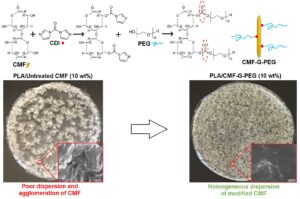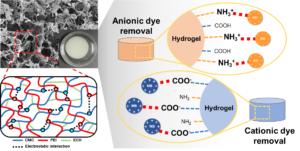Volume 17 Issue 4
Latest articles
- Researchpp 5655-5666Aykan, R., Avsar, C., Bilgiç, M. B., and Kesik, H. (2022). "Determining the effects of some bacteria on wooden toys treated with antibacterial protective coatings," BioResources 17(4), 5655-5666.AbstractArticlePDF
Several protective coatings enhanced by antimicrobial agents and/or pigments were considered for the wooden toy market: water-based matte varnish, an ultra-hygiene water-based matte varnish (WBV-UH), a polyurethane matte varnish (PUV), and an ultra-hygiene antiviral polyurethane matte varnish (PUV-UH), as well as a water-based dye (WBV 5%K), an ultra-hygiene water-based dye (WBV-UH 5%K), a polyurethane dye (PUV 5%K), and an ultra-hygiene polyurethane dye (PUV-UH 5%K), which contain 5% red nano-pigment (K). By utilizing 7 kinds of bacteria and 2 types of yeast that are commonly detected in routine, daily settings, the efficacy of the different protective coatings on wooden toy surface was investigated. The antibacterial and antimicrobial activities of the tested dye samples were based on the agar-well diffusion method. Ultimately, the study found that the addition of antimicrobial agents to several different protective coatings and dyes resulted in the presence of antimicrobial activity vs. the lack thereof with protective coatings and dyes alone. Additionally, some of the dyes with added antimicrobial agents were found to be effective against biofilm formation. Overall, the addition of pigment into the coating, alongside the addition of antimicrobial agents, proved to be highly effective in inhibiting growth and spread of microorganisms on wooden toy surface.
- Researchpp 5667-5678Chen, C., Xu, P., Wang, Z., Shi, J., Wang, G., and Wang, X. (2022). "Preparation and characterization of textile-grade long cellulose fibers and their yarns from windmill palm," BioResources 17(4), 5667-5678.AbstractArticlePDF
Windmill palm fiber (WPF) is an abundant source of cellulose fiber that can be used in textile manufacturing. In this study, acid-alkali palm fiber and acid-alkali-enzyme palm fiber were prepared to create blended yarns. The morphology, chemical composition, physical structural parameters, and tensile properties of the WPF samples and yarns were studied. The results indicated that both the acid-alkali and acid-alkali-enzyme treatments can be used as degumming methods to prepare windmill palm textile-grade long fibers with spinning ability. After chemical treatment, the cellulose content of WPF increased to more than 60%, up from 34%. However, the line densities of the acid-alkali and acid-alkali-enzyme textile-grade long fibers decreased to 5.29 ± 1.00 tex and 4.52 ± 0.82 tex, respectively. For the enzyme-treated fiber, a stratification phenomenon of the fiber cell walls and a decrease in the modulus were observed. The palm/cotton yarn had a high tensile strength and strip uniformity.
- Researchpp 5679-5694Lin, J., Li, J., Zhou, S., Cao, Y., Wang, S., and Jiao, J. (2022). "Solid acid catalyst WO3-ZrO2 for the catalytic deoxygenation of jatropha oil for the preparation of aviation paraffin," BioResources 17(4), 5679-5694.AbstractArticlePDF
WO3-ZrO2 solid acid catalysts were prepared by the impregnation method and characterized by X-ray diffraction (XRD), transmission electron microscope (TEM), Brunauer-Emmett-Teller (BET), and pyridine adsorbed IR spectroscopy (Py-IR). The catalysts were used for catalytic deoxygenation of Jatropha curcas oil. The optimal conditions for the deoxygenation of the generated oil were obtained by response surface methodology based on Box-Behnken four-factor experiments. Response surface methodology (RSM) was applied while determining the optimal conditions for the Jatropha oil deoxygenation percentage. The rate was calculated based on Box-Behnken four-factor experiments, with reaction temperature, catalyst amount, reaction time, and reaction pressure as independent variables and the deoxygenation of Jatropha curcas oil as response values. The optimal reaction conditions obtained were a temperature of 370 °C, pressure of 2 MPa, time of 7 h, and catalyst amount of 0.22 g. The deoxygenation percentage of the generated oil under the optimal conditions was 95.1%, which was close to the theoretical value, indicating that the model was reliable. The generated oil contained more jet fuel components, with 68.1% C8-C16, 12.0% isoalkanes, 14.2% cycloalkanes, and 8.9% aromatic compounds under the optimum conditions. This study provides an effective and simple method for preparation of bio-aviation fuel.
- Researchpp 5695-5706Hassanpoor Tichi, A., and Gholamiyan, H. (2022). "Using wollastonite nanomaterials in gypsum-wood composites," BioResources 17(4), 5695-5706.AbstractArticlePDF
In this study, the effect of wollastonite on mechanical, physical, and morphological properties of composites made of sesame stem (Sesamum indicum L.) and gypsum was investigated. The mixing ratio of sesame stem as a lignocellulosic material with gypsum at three levels (10:90, 20:80, and 30:70) and wollastonite at three levels (0%, 5%, and 10%, based on dry weight of cement) were considered as the variables. Fire resistance (weight loss) was tested according to ISO 11925-3 and DIN EN 634-1 and two specifications for the mechanical and physical properties. Microstructural properties of composites were evaluated by scanning electron microscopic (SEM) imaging. The results showed that boards containing wollastonite increased the physical and mechanical properties compared with gypsum board without wollastonite. The modulus of rupture, modulus of elasticity, and internal bonding of the boards decreased with increased sesame stemcontent, and its maximum value was obtained when using 10% sesame stem. The addition of 10% wollastonite is recommended to significantly improve the fire retardancy of the boards. The results from SEM images showed that the wollastonite can fill in the gaps inside the boards and create a solid structure.
- Researchpp 5707-5727Dadras Chomachayi, M., Blanchet, P., and Hussain, A. (2022). "Development of bio-based membranes for building envelope applications from poly(lactic acid) and cellulose microfibers," BioResources 17(4), 5707-5727.AbstractArticlePDF

A bio-based membrane was developed for building envelope applications. Biocomposites with enhanced water vapor permeability were fabricated based on poly(lactic acid) (PLA) and cellulose microfibers (CMF). To improve the interfacial adhesion between PLA and fibers, polyethylene glycol (PEG) was used as a compatibilizer for the modification of CMF. The properties of prepared PLA-based biocomposites were investigated in terms of their morphology, thermal stability, thermomechanical properties, and water vapor permeability. The morphological investigation showed the improved dispersion of cellulose fibers in the PLA matrix after modification of the bio-filler with PEG. The thermogravimetric analysis illustrated that the addition of modified CMFs increased the thermal stability of materials. Moreover, the water vapor permeability of PLA-based biocomposites was enhanced by adding modified CMFs to the PLA matrix. The results suggest that the utilization of PEG as a biopolymer compatibilizer represents a cost-effective and environmentally friendly method to improve the properties of PLA/CMF biocomposites. The developed membranes are potential materials for the fabrication of bio-based membranes with permeable properties that facilitate the transmission of entrapped water vapor through the building, eventually prolonging the service life of building envelope materials.
- Researchpp 5728-5740Xing, T., Dong, C., Hu, X., Zhang, J., Zhao, Y., Xue, J., and Wang, X. (2022). "Theoretical study on the interactions between cellulose and different methyltriethoxysilane hydrolysis products," BioResources 17(4), 5728-5740.AbstractArticlePDF
Silylation is an effective means of cellulose modification. However, the condensation reaction process between the hydrolysis products of the silane coupling agent and cellulose, as well as the structure of the coating, which both have a strong influence on the wettability, are still controversial. In this paper, the reactions of different methyltriethoxysilane hydrolysis products with cellulose were simulated via the density functional theory method. The reaction activity centers of the different methyltriethoxysilane hydrolysis products in an ethanol solution were analyzed via the front-line orbital theory and the Fukui function. The silylation reaction of different methyltriethoxysilane hydrolysis products in an ethanol solution on the cellulose surface were investigated via the transition state theory. The results show that although the initial hydrolysis product has the lowest grafting energy barrier, considering the whole process of grafting and condensation on the cellulose surface, the hydrolysis product with two hydroxyl groups is more favorable for the growth of organosilicon on the cellulose surface, so it is desirable to control the reaction where this product is dominant. In addition, the silylation process on the cellulose surface is more inclined to a multilayer coating mechanism.
- Researchpp 5741-5754Shih, Z.-T., and Young, W.-B. (2022). "Study on the relaxation behavior of bamboo fiber as a function of temperature and moisture content," BioResources 17(4), 5741-5754.AbstractArticlePDF
The tensile relaxation behavior of bamboo fiber was evaluated. Bamboo fibers were extracted via a mechanical method and treated in alkaline solutions of sodium hydroxide. The relaxation tests of bamboo fibers were conducted by applying a constant strain at one end of a single bamboo fiber while the other end was fixed. The reaction force in the bamboo fiber was measured at the same time. The relaxation tests of the bamboo fibers were conducted under different temperature and moisture contents. The results showed that in the wet and/or high temperature conditions, the relaxation rate was faster than that in the dry and/or room temperature conditions. For a low strain, the bamboo fiber can be totally relaxed within 10 min under a high temperature. A nonlinear viscoelastic constitutive model was proposed to fit the relaxation curves, which could model the stress relaxation behavior of a bamboo fiber under different temperature or moisture content conditions. Compared with the experimental data, the model gave reasonable values for the relaxation behavior of the bamboo fiber.
- Researchpp 5755-5768Siegel, C., Buchelt, B., and Wagenführ, A. (2022). "Transfer of the interlaminar shear test to veneer layer-based composites for qualitative evaluation of layer adhesion," BioResources 17(4), 5755-5768.AbstractArticlePDF
This study aimed to investigate the suitability of the interlaminar shear (ILS) testing method for veneer-based composites. The ILS testing method is an established method for composite materials as a qualitative evaluation of the adhesion within the composite. The applicability of this method to veneer based composites enables a simple qualitative statement on the adhesion of the individual layers. The ILS method complements existing wood-based material tests that focus on bonding, using significantly smaller material dimensions.
- Researchpp 5769-5784Sandahl, A., Pedersen, L. S., Taarning, E., and Lindhardt, A. (2022). "Evaluation of glycolaldehyde as a formaldehyde substitute in urea-based wood adhesives," BioResources 17(4), 5769-5784.AbstractArticlePDF

Glycolaldehyde, produced from cracking of glucose, was tested as a substitute for formaldehyde in urea-based wood adhesives. Initially, different parameters (water content, aldehyde/urea-ratio, curing temperature, and time) were screened to identify the optimal curing conditions providing the highest bond strength. Afterwards, the system was reformulated as a 2-component system and compared to a urea-formaldehyde 2-component system, which showed a comparatively low strength of the resulting resin. Different hardeners were tested, and AlCl3 showed an 80% increase in bond strength for the resin compared to NH4Cl. Infrared and nuclear magnetic resonance analyses were performed to ensure formation of the desired aminal bond network, which showed that the hardener was essential for proper curing of the resin. Finally, a urea-glycolaldehyde-formaldehyde resin was tested that further indicated major differences between the reactivity of formaldehyde and glycolaldehyde.
- Researchpp 5785-5802Jung, M., Kim, J., Jung, S., Kim, Y., Bang, J., Yeo, H., Choi, I., and Kwak, H. (2022). "pH-responsive hydrogels of carboxymethyl cellulose and polyethyleneimine for efficient removal of ionic dye molecules," BioResources 17(4), 5785-5802.AbstractArticlePDF

A carboxymethyl cellulose (CMC)/polyethyleneimine (PEI) hybrid hydrogel was successfully prepared under green processing conditions. The CMC and PEI formed a polyelectrolyte complex, and the three-dimensional (3D) network structure was hardened by chemical crosslinking, resulting in suitable hydrogel properties. In the prepared CMC/PEI polyelectrolyte hydrogel, the surface charge was easily switched according to the pH change, and the resulting swelling and contraction was reversible. The pH sensitivity of the CMC/PEI hydrogel was effective in removing ionic dye contaminants, and as a result, it showed an excellent removal capacity of 319 mg/g for anionic acid orange (AO) and 129 mg/g for cationic methylene blue (MB). In addition, the CMC/PEI polyelectrolyte hydrogel maintained structural stability despite repeated changes in surface charge characteristics and shrinkage-swelling due to repeated pH conversion. As a result, in the reuse process through repeated adsorption and desorption, it showed an excellent reuse efficiency of more than 93% even after 10 reuse cycles.
